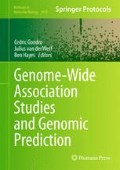Abstract
Genomic prediction exploits historical genotypic and phenotypic data to predict performance on selection candidates based only on their genotypes. It achieves this by a process known as training that derives the values of all the chromosome fragments that can be characterized by regressing the historical phenotypes on some or all of the genotyped loci. A genome-wide association study (GWAS) involves a genome-wide search for chromosome fragments with significant association with phenotype. One Bayesian approach to GWAS makes inferences using samples from the posterior distribution of genotypic effects obtained in the training phase of genomic prediction. Here we describe how to do this from commonly used Bayesian methods for genomic prediction, and we comment on how to interpret the results.
Access this chapter
Tax calculation will be finalised at checkout
Purchases are for personal use only
References
Hindorff LA, MacArthur J (European Bioinformatics Institute), Wise A, Junkins HA, Hall PN, Klemm AK, Manolio TA (2012). A catalog of published genome-wide association studies. www.genome.gov/gwastudies. Accessed 16 May 2012
Hao K, Chudin E, Greenawalt D, Schadt EE (2010) Magnitude of stratification in human populations and impacts on genome wide association studies. PLoS One 5(1):e8695
Snelling WM, Allan MF, Keele JW, Kuehn LA, McDaneld T, Smith TPL, Sonstegard TS, Thallman RM, Bennett GL (2010) Genome-wide association study of growth in crossbred beef cattle. J Anim Sci 88:837–848
Meuwissen THE, Hayes BJ, Goddard ME (2001) Prediction of total genetic value using genome-wide dense marker maps. Genetics 157:1819–1829
Toosi A, Fernando RL, Dekkers JCM (2010) Genomic selection in admixed and crossbred populations. J Anim Sci 88:32–46
Allen DM, Cady FB (1982) Analyzing experimental data by regression. Lifetime Learning, Belmont, CA, p 64
Fernando RL, Garrick DJ. Bayesian methods applied to GWAS. In: Gondro C (ed) Genome-wide association studies and genomic prediction. Methods Mol Biol 1019:235–272
Sorenson D, Gianola D (2002) Likelihood, Bayesian and MCMC methods in quantitative genetics. Springer, New York, p 740. ISBN 0-387-954406
Illumina (2006) Technical Note: “TOP/BOT” strand and “A/B” allele. http://www.illumina.com/documents/products/technotes/technote_topbot.pdf. Accessed 16 May 2012
Pongpanich M, Sullivan PF, Tzeng JY (2010) A quality control algorithm for filtering SNPs in genome-wide association studies. Bioinformatics 26:1731–1737
Haley CS, Knott SA (1992) A simple regression method for mapping quantitative trait loci in line crosses using flanking markers. Heredity 69:315–324
Marchini J, Howie B (2010) Genotype imputation for genome-wide association studies. Nat Rev Genet 11:499–511
Weller JI, Kashi Y, Soller M (1990) Power of daughter and granddaughter designs for determining linkage between marker loci and quantitative trait loci in dairy cattle. J Dairy Sci 1990(73):2525–2537
Garrick DJ, Taylor JF, Fernando RL (2009) Deregressing estimated breeding values and weighting information for genomic regression analyses. Genet Sel Evol 41:55
Ostersen T, Christensen OF, Henryon M, Su G, Madsen P (2011) Deregressed EBV as the response variable yield more reliable genomic predictions than traditional EBV in pure-bred pigs. Genet Sel Evol 43:38
Gilmour AR, Gogel BJ, Cullis BR, Thompson R (2008) ASReml user guide release 3.0. VSN, Hemel Hempstead
de los Campos G, Naya H, Gianola D, Crossa J, Legarra A, Manfredi E, Weigel K, Cotes J (2009) Predicting quantitative traits with regression models for dense molecular markers and pedigree. Genetics 182:375–385
Henderson CR (1984) Applications of linear models in animal breeding. University of Guelph, Guelph, ON
Fernando RL, Habier D, Stricker C, Dekkers JCM, Totir LR (2007) Genomic selection. Acta Agric Scand A Anim Sci 57:192–195
Gianola D, de los Campos G, Hill WG, Manfredi E, Fernando R (2009) Additive genetic variability and the Bayesian alphabet. Genetics 183:347–363
ter Braak CJF, Boer MP, Bink MCAM (2005) Extending Xu’s Bayesian model for estimating polygenic effects using markers of the entire genome. Genetics 170:1435–1438
Xu S (2007) An empirical Bayes method for estimating epistatic effects of quantitative trait loci. Biometrics 63:513–521
Habier D, Fernando RL, Kizilkaya K, Garrick DJ (2011) Extension of the Bayesian alphabet for genomic selection. BMC Bioinformatics 12:186
Hoeschele I, Tier B (1995) Estimation of variance components of threshold characters by marginal posterior modes and means via Gibbs sampling. Genet Sel Evol 27:519–540
Hayes BJ, Pryce J, Chamberlain AJ, Bowman PJ, Goddard ME (2010) Genetic architecture of complex traits and accuracy of genomic prediction: coat colour, milk-fat percentage, and type in Holstein cattle as contrasting model traits. PLoS Genet 6(9):e1001139
Author information
Authors and Affiliations
Editor information
Editors and Affiliations
Rights and permissions
Copyright information
© 2013 Springer Science+Business Media, LLC
About this protocol
Cite this protocol
Garrick, D.J., Fernando, R.L. (2013). Implementing a QTL Detection Study (GWAS) Using Genomic Prediction Methodology. In: Gondro, C., van der Werf, J., Hayes, B. (eds) Genome-Wide Association Studies and Genomic Prediction. Methods in Molecular Biology, vol 1019. Humana Press, Totowa, NJ. https://doi.org/10.1007/978-1-62703-447-0_11
Download citation
DOI: https://doi.org/10.1007/978-1-62703-447-0_11
Published:
Publisher Name: Humana Press, Totowa, NJ
Print ISBN: 978-1-62703-446-3
Online ISBN: 978-1-62703-447-0
eBook Packages: Springer Protocols

